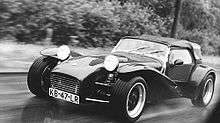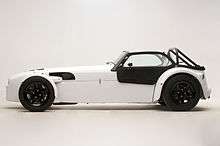Donkervoort
 | |
| Industry | Automotive |
|---|---|
| Founded | 1978 |
| Founder | J.A. Donkervoort |
| Headquarters | Lelystad, Netherlands |
| Products | Hand-built ultra-light weight sport cars |
Number of employees | 20–25 |
| Website | Donkervoort Official Site |
Donkervoort Automobielen BV is a manufacturer of authentic hand-built and ultra light weight sports cars based in Lelystad, Netherlands. The car brand was founded in 1978 by Joop Donkervoort.
In 1996, Donkervoort's Ford engines were replaced by Audi engines. Donkervoort's motto – "No Compromise" – means driving without any electronic aids such as ABS (Anti-lock braking system), Electronic stability program (ESP) or power steering.
Previous models

- Donkervoort S7
The first Donkervoort – the S7 – was introduced in 1978. These cars have a Ford Crossflow 1.6 liter OHV engine with 90 PS (66 kW) and a four-speed manual transmission. Top speed was 170 km/h (106 mph).[1]
- Donkervoort S8/S8A
Introduced in late 1983, the S8 and later S8A were the first Donkervoorts of notice, with the "Eight" implying an improvement over the Lotus Seven. Of exactly the same dimensions as the Donkervoort Super Seven, these cars originally used a two-liter inline-four engine from Ford of Europe.[1]
- Donkervoort S8AT
Responding to the need for more power, a turbocharged version of the S8 soon appeared; this car is identifiable by a profusion of various vents and openings to cool the engine.
- Donkervoort D10
This sleek, minimalist version was built in a very limited series of ten to celebrate Donkervoort's tenth anniversary in 1988. The cars lacked a spare wheel as well as a windshield, but benefitted from an enlarged (2,160 cc) version of the Ford engine with a bigger Garrett T3 turbocharger, producing 190 PS (140 kW). The last car was only built in 1994, with some of the later examples receiving Cosworth engines with up to 300 PS (221 kW).[2]
- Donkervoort D8 ZETEC (1993-1999)
From 1993 the real Donkervoort was built. A monsterous drive with outrageous character and a marvelous sound: The Donkervoort D8 1.8 and 2.0 ZETEC. When you see a Donkervoort tour, with several types, you can hear the Zetec. A very specific deep sound, that gives you the shiver and goosebumps when you are in the drivers seat. The ZETEC is a drivers car for the grand tour. Not a car for the circuit, but hot to handle at fast corners and delightfull in sharp steering.
- Donkervoort D8 Audi (E-gas) Wide Track (2003–2012)

Since 2003, the Donkervoort is equipped with the Audi 1.8T 20V E-gas turbocharged engine. In the D8, the engine is available with 150 bhp, 180 bhp, 210 bhp and 270 bhp. Thanks to its total weight of 630 kilograms, this results in an acceleration time from 0 to 100 km/h between 3.8 and 5.2 seconds depending on the type.
- Donkervoort D8 270 (2008–2012)

The Donkervoort D8 270 is available since the summer of 2008. This version of the D8 series became the successor of the D8 270 RS, the limited edition that was introduced in 2005. The D8 270 has a restyled nose and grill that refer directly to the D8 GT and accelerates from 0–100 km/h in 3.6 seconds.
This car was as of 2011 one of the ten fastest production cars on the famous Nurburgring Nordschleife at 7m 14.9s.[3]
- Donkervoort D8 GT (2007–2012)
The Donkervoort D8 GT - introduced in 2007 - is the first closed Donkervoort. Compared to the open version of the D8, the D8 GT has entirely new front and rear suspension, increased track width by 8 centimeters, larger brakes for increased stopping power and 17-inch aluminum wheels. With a total weight of 650 kg, the D8GT is the lightest GT in the world. This is largely due to the extensive use of carbon fiber: the entire roof, the entire rear and the doors and fenders of the car are made of this material.
Current models
- Donkervoort D8 GTO (2013–present)
The Donkervoort D8 GTO is a completely new creation. The engine, a 2.5L TFSI 5-cylinder turbocharged Audi engine, has a power output of 250-280 kW (340-380PS) and 450Nm of torque at 1600rpm, and the whole car weighs less than 700 kg. This low weight is due to composite materials such as the full carbon fibre body of the D8 GTO. With a power-to-weight ratio of just 1.8 kg/PS the car accelerates from 0–100 km/h in 2.8s and from 0–200 km/h in just 8.6s.
The very first GTOs were produced in a limited series of 25 Premium D8 GTOs in 2013. The production of the regular D8 GTO, available in a Touring or a Performance version, started in 2014.
- Donkervoort D8 GTO Premium (2013)
The Premium D8 GTO's were the first GTO's to be produced. After a sneak preview event introducing the D8 GTO in December 2012, existing customer were able to obtain one of these full option GTO's. The Premium D8 GTO were built as a limited series of 25 cars and had a little more power (380+ BHP) than e.g. the D8 GTO Performance.
- Donkervoort D8 GTO Bilster Berg Edition (2014–2015)
In September 2014, the Donkervoort D8 GTO broke the lap record at the German Bilster Berg Drive Resort. The 380 hp Performance version set the new record for street-legal production cars at 1 minute 46.12 seconds. To celebrate this milestone – along with the opening of a Donkervoort subsidiary at that same location that year, Donkervoort introduced the Bilster Berg Edition, which was based on the record-breaking test car and built in a limited series of just 14 cars, a number that represented the successful year 2014. Technical developments included the further development and fine-tuning in the areas of chassis and road-handling. Furthermore, this edition is easily recognisable by its dark nose section, made entirely of carbon fibre.
Model overview
| Vehicle | Year | Engine |
|---|---|---|
| S7 | 1978–1984 | 1.6 L Ford Crossflow OHV engine, 90 PS |
| S8 | 1980–1984 | 2.0 L Ford OHV, 103 PS (76 kW) |
| S8A | 1985–1993 | 2.0 L Ford OHC, 117 PS (86 kW) |
| S8AT | 1986–1994 | Garrett T3 turbocharger, intercooler, 3 way catalytic converter, 170 PS (125 kW) as a 2.0 L engine/190 PS as a 2.2 L |
| D10 | 1988–1989 | 2,160 cc Ford Garrett T3 turbocharger, 190 PS (140 kW) |
| D8 Zetec | 1993–1998 | 1.8 L or 2.0 L 16V Zetec engine, 140 PS (103 kW) or 160 PS (118 kW) |
| D8 Cosworth | 1994–1998 | 2.0 L DOHC engine, 220 to 280 PS (206 kW) |
| D8 Audi (AGU) | 1999–2002 | Turbocharged 1.8 L Audi engine, 150-245 PS |
| D8 Audi (E-gas) | 2003–present | Turbocharged 1.8 L Audi engine, drive by wire, 150-270 PS |
| D8 270 RS | 2005–2007 | Turbocharged 1.8 L Audi engine, drive by wire, 270 PS (199 kW) |
| D8 270 | 2008–present | Turbocharged 1.8 L Audi engine, drive by wire, 270 PS (199 kW) Special |
| D8 GT | 2007–present | Turbocharged 1.8 L, 20-valve Audi engine, drive by wire, 270 PS (199 kW) |
| D8 GTO | 2013–present | Turbocharged 2.5 L TFSI 5-cylinder Audi engine, 250-280 kW (340-380 PS) |
References
- 1 2 Mastrostefano, Raffaele, ed. (1985). Quattroruote: Tutte le Auto del Mondo 1985 (in Italian). Milano: Editoriale Domus S.p.A. p. 261. ISBN 88-7212-012-8.
- ↑ "D10-page". Donkervoort Automobilia. Retrieved 2011-11-11.
- ↑ "Fastest Production Car Lap of the Nurburgring". Bridgetogantry.com. 2011-03-18.
External links
| Wikimedia Commons has media related to Donkervoort vehicles. |
- Official Website Donkervoort Automobielen B.V
- Donkervoort D8 GTO First Heartbeat
- Donkervoort - 24H Dubai
- Donkervoort Discovery Channel
- Donkervoort fan site with lots of independent information, pictures etc.
- Donkervoort D8 GTO Test drive (FR)